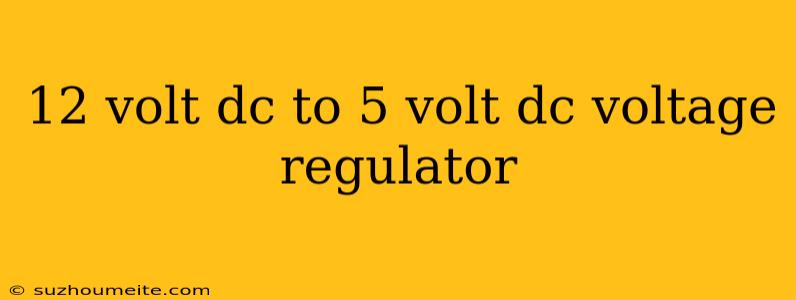12 Volt DC to 5 Volt DC Voltage Regulator
Introduction
In many electronic projects, having a stable and regulated voltage supply is crucial to ensure the proper functioning of the devices. When working with devices that require a specific voltage, such as 5V, but the available power source is 12V, a voltage regulator is necessary to step down the voltage. In this article, we will explore the concept of a 12V DC to 5V DC voltage regulator and how it works.
What is a Voltage Regulator?
A voltage regulator is an electronic device that regulates the output voltage of a power source to a specific level, ensuring that the voltage remains constant despite changes in the input voltage or load current. The main purpose of a voltage regulator is to provide a stable voltage supply to electronic devices, preventing damage from voltage fluctuations.
How Does a 12V DC to 5V DC Voltage Regulator Work?
A 12V DC to 5V DC voltage regulator works by reducing the input voltage from 12V to the required 5V output voltage. This is achieved through a process called voltage regulation, which involves the following steps:
Voltage Reduction
The input voltage of 12V is applied to the voltage regulator, which then reduces the voltage to the required 5V output voltage.
Voltage Regulation
The voltage regulator continuously monitors the output voltage and adjusts the voltage reduction as needed to maintain a stable 5V output voltage.
Load Regulation
The voltage regulator also regulates the output voltage to ensure that it remains constant despite changes in the load current.
Types of Voltage Regulators
There are several types of voltage regulators available, including:
Linear Voltage Regulators
Linear voltage regulators use a voltage-controlled current source to regulate the output voltage. They are simple to use and provide a stable output voltage, but are less efficient than switching regulators.
Switching Voltage Regulators
Switching voltage regulators use a high-frequency switching circuit to regulate the output voltage. They are more efficient than linear regulators and can handle higher currents.
Low Dropout Voltage Regulators
Low dropout voltage regulators are designed to operate with a low voltage dropout, making them suitable for applications where the input voltage is close to the output voltage.
Popular Voltage Regulator ICs
Some popular voltage regulator ICs for 12V DC to 5V DC voltage regulation include:
LM7805
The LM7805 is a popular linear voltage regulator IC that can deliver up to 1A of output current.
LT1084
The LT1084 is a low dropout voltage regulator IC that can deliver up to 3A of output current.
SPX3810
The SPX3810 is a switching voltage regulator IC that can deliver up to 1A of output current.
Conclusion
In conclusion, a 12V DC to 5V DC voltage regulator is an essential component in many electronic projects, providing a stable and regulated voltage supply to devices that require 5V. By understanding how voltage regulators work and choosing the right type of voltage regulator for your application, you can ensure the proper functioning of your devices and prevent damage from voltage fluctuations.
